Authors: Dion Nissenbaum
A Street Divided (34 page)
Chapter Eight: The Architects of Division
1.
Natasha Mozgovaya, “Would East Jerusalem Arabs Rather Be Citizens of Israel or Palestine?”
Haaretz,
January 13, 2011.
“100,000 Trees for Jerusalem Border.”
Jerusalem Post.
August 15, 1957.
Amichai, Yehuda.
Poems of Jerusalem and Love Poems.
New York: Sheep Meadow Press, 1988.
Bennike, Maj. Gen. Vagn. Letter to UN Security Council. UN Truce Supervision Organization, December 12, 1953, Jerusalem. UN Archives and Records Center, New York City, New York.
Benvenisti, Meron.
City of Stone: The Hidden History of Jerusalem.
Berkeley: University of California Press, 1996.
“Betrothal in No-Man's-Land.”
Jerusalem Post.
November 15, 1956.
“Couple Married in No-Man's-Land.”
Jerusalem Post.
September 14, 1956.
Felner, Eitan. “Playing with Fire on the Temple Mount.”
B'Tselem,
December 1996,
http://www.btselem.org/publications/summaries/199612_playing_with_fire
.
Franklin, Stephen. “Uprising Shattering Jerusalem's Dream of Coexistence.”
Chicago Tribune,
January 14, 1990.
“High Court Throws Out Flat-Jumpers Claims.”
Jerusalem Post.
July 21, 1967.
Hudson, Deal. “A City Divided: How Israel's Wall Is Splitting the Holy Land.”
Crisis Magazine,
January 10, 2005,
http://www.crisismagazine.com/2005/a-city-divided-how-israels-wall-is-splitting-the-holy-land
.
“Husband Cools Off in No Man's Land.”
Jerusalem Post.
August 16, 1959.
Hutchison, E. H.
Violent Truce: A Military Observer Looks at the Arab-Israeli Conflict, 1951â1955.
New York: The Devin-Adir Company, 1956.
Israeli, Raphael.
Jerusalem Divided: The Armistice Regime, 1947â1967.
London: Frank Cass & Co., 2002.
“Jordan Yields Wrong Sheep.”
Jerusalem Post.
February 11, 1958.
Katz, Yossi. “Israeli Tree Planting in the Armon Hanatziv (the former British Government House) Area in the Summer of 1957.” Unpublished manuscript, March 2015. Provided to author by Jewish National Fund.
Keinon, Herb. “Baum Appointment Draws Protests, Praise Tough New Commander in Abu Tor.”
Jerusalem Post,
December 8, 1989.
Narkiss, Uzi.
The Liberation of Jerusalem.
London: Valentine Mitchell, 1983.
New York Times News Service. “Nuns Recover Dentures from No Man's Land.”
Milwaukee Journal,
May 23, 1956.
Reports, Jordan-Israel Mixed Armistice Commission, UN Archives and Records Center, New York City, New York.
Rabinovich, Abraham.
The Battle for Jerusalem: June 5â7, 1967.
The Jewish Publication Society of America, 1972.
Transcripts, UN Security Council Meetings, September 6, 1957, Library of Congress, Washington, D.C.
“Two More Held for Flat-Jumping.”
Jerusalem Post.
July 20, 1967.
Weizman, Eyal.
Hollow Land: Israel's Architecture of Occupation.
London: Verso, 2007.
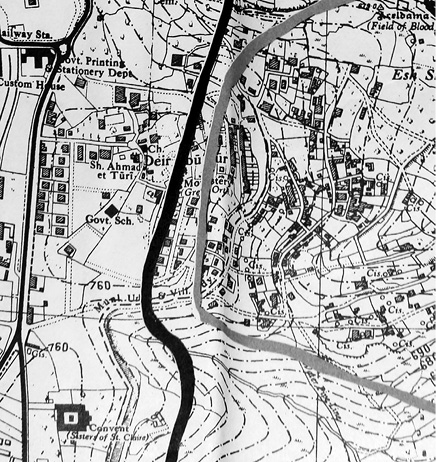
A UN copy of the cease-fire lines through Jerusalem's Abu Tor neighborhood, as drawn with grease pencils by Israeli general Moshe Dayan (left, in red) and Jordanian officer Abdullah El-Tell (right, in green) in 1948. Modern-day Assael Street runs through the middle of the two lines. Photo by Dion Nissenbaum.

A French officer holding a white flag and an Israeli soldier watch in May 1956 as nuns from a French hospital in West Jerusalem search for a patient's dentures that had fallen from a window overlooking No Man's Land. Photo by David Rubinger.
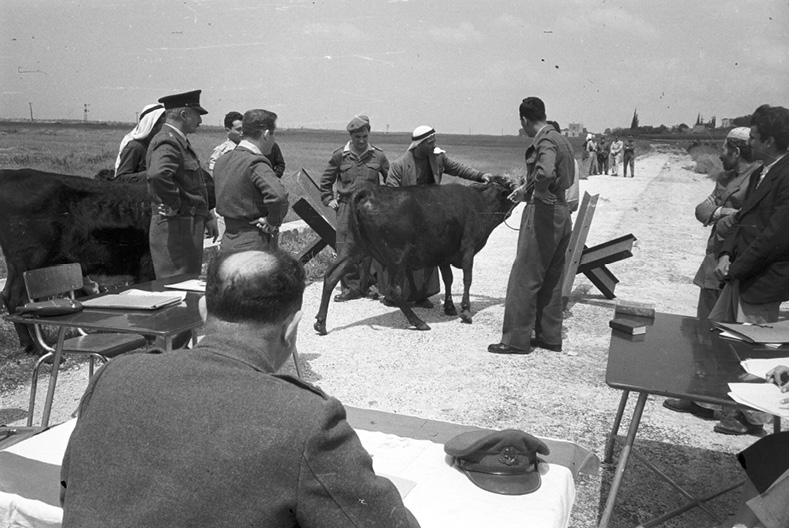
Israeli and Jordanian officials set up a makeshift court in No Man's Land north of Jerusalem in May 1957 to decide the fate of cows that farmers on both sides of the border claimed were theirs. Photo by David Rubinger.
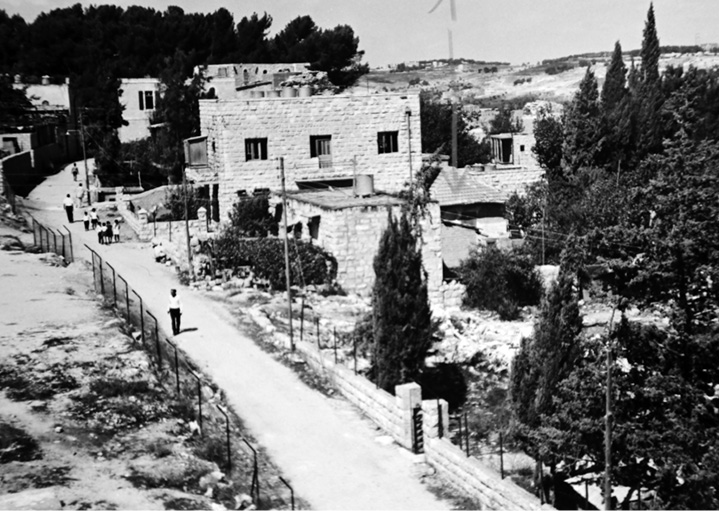
Photograph from the UN investigation in September 1966 into the return of the Yaghmour family to No Man's Land. Malka Joudan, an Iranian immigrant to Israel whose house on the edge of modern-day Assael Street is identified by the faint arrow, called to alert officials to the Palestinian family's return. Photo via UN Archives and Records Management Section.
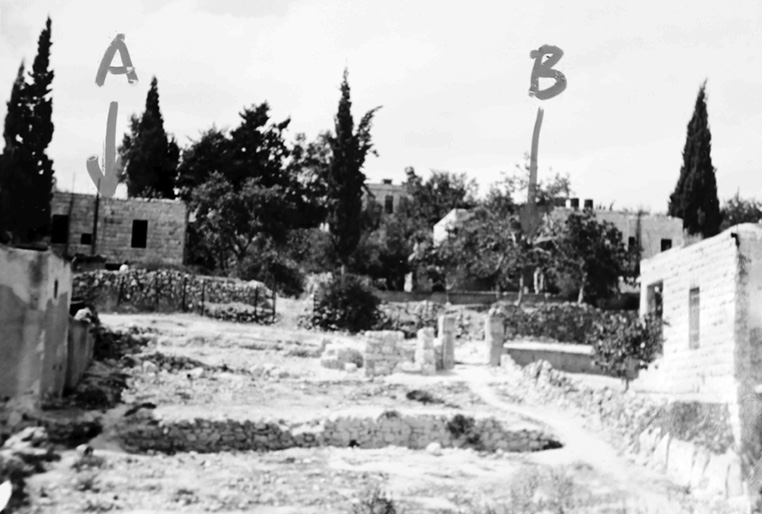
A UN photo from 1966 shows No Man's Land in Abu Tor from the Jordanian side. This photo was part of a UN investigation into the Yaghmour family's return to their home between the barbed wire separating Israel and Jordan. Photo courtesy UN Archives and Records Management Section.

A Scottish officer working for the United Nations and an Israeli paratrooper lead a joint Israeli-Jordanian medical team tossing poisoned meat in No Man's Land in December 1957, along the “Barbed Wire Alley” that later became Assael Street in Jerusalem. Photo by David Rubinger.

Palestinian residents of Abu Tor, Jerusalem, march off for questioning by Israeli soldiers at the end of the June 1967 war. Photo by Shimshon Jacoby.
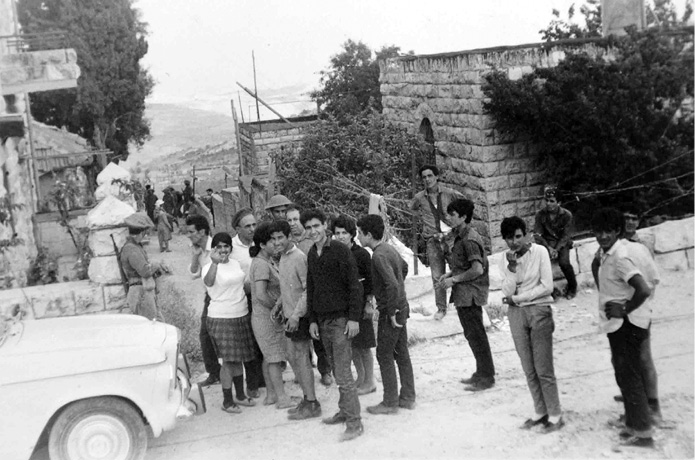
Members of the Joudan family gather with other neighbors outside their Abu Tor home right above No Man's Land at the end of the June 1967 war. An Israeli soldier keeps an eye out for Israeli looters carrying stuff from Palestinian homes in No Man's Land. Photo by Shimshon Jacoby.
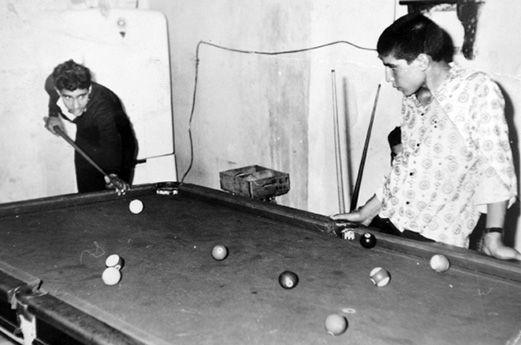
Israeli and Palestinian boys play pool at a lower Abu Tor community center some time after the 1967 war. Photo by Shimshon Jacoby.
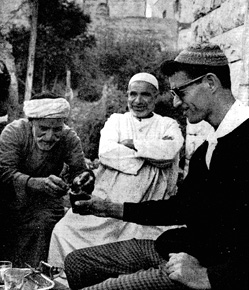
Eid Yaghmour (left) serves tea to Haim Machsomi (right) on Assael Street in May 1969 after the barbed wire came down and the men were able to shake hands for the first time. “We are happy to be pioneers in bringing together the hearts of the two people,” Haim wrote in a petition at the time for better city services. Photo courtesy Werner Braun/Jerusalem Post.
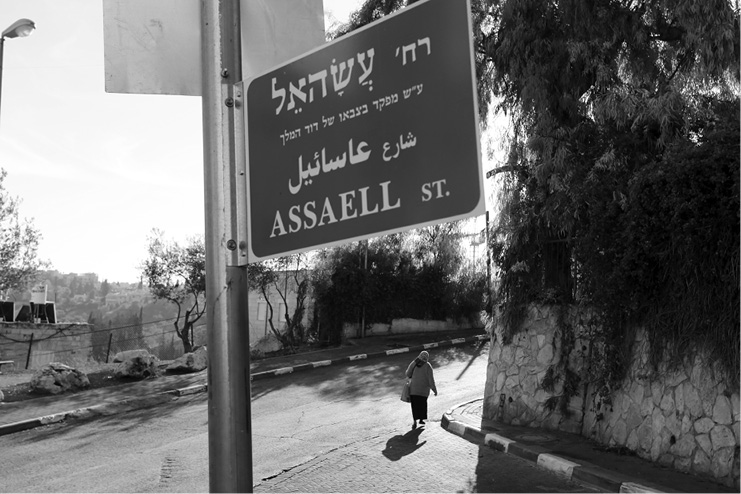
A sign in Hebrew, Arabic and English marks the beginning of Assael Street. People who live here disagree on where the street gets its name and how to spell it in English. Photo by Dion Nissenbaum.

Nawal and Zakaria Bazlamit stand outside their home on Assael Street in 2007. Until 1967, their property marked the edge of No Man's Land with Israel. Photo by Katherine Kiviat.